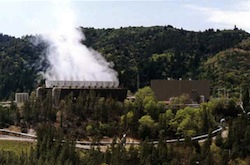 The Geothermal Energy Association (GEA) has released a new report to coincide with the California Air Resources Board’s (CARB) development of a scoping plan for implementing their climate law AB 32. The report finds that California’s geothermal resources are remain largely untapped.
The Geothermal Energy Association (GEA) has released a new report to coincide with the California Air Resources Board’s (CARB) development of a scoping plan for implementing their climate law AB 32. The report finds that California’s geothermal resources are remain largely untapped.
Geothermal power is “a viable, cost effective, and plentiful renewable energy option to meet California’s climate goals,” GEA told CARB. Utilizing the Golden State’s geothermal resources can help achieve “carbon reductions with the least total cost and highest power system reliability,” GEA reports.
In brief, the status report, Report on the State of Geothermal Energy in California, shows that:
- Geothermal power generated 4.4% of total system power in California in 2012, but could have generated substantially more.
- Geothermal power produces some of the lowest life-cycle emissions when compared to almost every other energy technology and even some renewables.
- Depending on the resource characteristics and plant design, geothermal power plants can be engineered to provide firm and/or flexible power.
- Even with high upfront capital costs, geothermal power is a competitive renewable energy source.
- About half of California’s identified geothermal resources are still untapped, and significant resources may remain undiscovered.
- Geothermal power is key to achieving an expanded renewable power portfolio at the lowest total cost.
- New technology will reduce geothermal power risks and can expand the supply curve to make more resources commercially available.
- The Salton Sea Known Geothermal Resource Area (SSKGRA) is considered by many to be the best opportunity for growth in California in the near term.
- Distributed generation geothermal power and heating projects have potential in a number of areas, but are not eligible for the type of support provided other distributed generation projects.
- Challenges to growth of utility scale plants include weak demand, inadequate transmission, permitting delays, and a lack of coordinated policies.

